
http://www.iaeme.com/IJM/index.as 97 editor@iaeme.com
International Journal of Management (IJM)
Volume 8, Issue 3, May– June 2017, pp.97–104, Article ID: IJM_08_03_010
Available online at
http://www.iaeme.com/ijm/issues.asp?JType=IJM&VType=8&IType=3
Journal Impact Factor (2016): 8.1920 (Calculated by GISI) www.jifactor.com
ISSN Print: 0976-6502 and ISSN Online: 0976-6510
© IAEME Publication
THE MANAGEMENT OF STAFF SUGGESTIONS
FOR KNOWLEDGE CREATION
Lamiae Bentaleb and Prof. Mimoun Zouhdi
Faculty of Medicine and Pharmacy,
University of Mohamed V – Souissi. Rabat, Morocco
ABSTRACT
Companies evolve in a complex and changeable environment. Competition,
internationalization of markets, modern information and communication technology
are elements which characterize this environment. To face this evolving environment,
companies owe have to ensure the continuous improvement of their performances.
Quality management guarantees this objective. Several standards exist as ISO 9001,
ISO 15189, and ISO 17025. Dependent on the context of different companies. Quality
management presents an optimal frame for the creation of new knowledge- a knowledge
that can constitute a competitive advantage and an element of distinction for companies.
Staff suggestions are a source of new knowledge. For a long time Man felt the need
to emit suggestions to improve his environment and the various aspects of his everyday
life. For companies, the suggestions stimulate the creativity of their staff, help to
decrease errors, and improve activities.
This paper explores the role of management of staff suggestions for knowledge
creation. It also proposes a framework for the management of staff suggestions within
a quality management system.
Key words: Staff suggestions, Quality management, Creation, Knowledge, Continuous
improvement.
Cite this Article: Lamiae Bentaleb and Prof. Mimoun Zouhdi, The Management of
Staff Suggestions For Knowledge Creation. International Journal of Management, 8(3),
2017, pp. 97–104.
http://www.iaeme.com/ijm/issues.asp?JType=IJM&VType=8&IType=3
1. INTRODUCTION
Everyone agrees on the importance of knowledge management. Indeed, for several years,
businesses that have started investing in knowledge management approaches and whose interest
is in performance improvement have seen major successes.
Today, various sources enrich knowledge. Unfortunately, this knowledge can be influenced
by an individual’s vision. With this being the case, it is hard to guarantee collective enrichment
and knowledge transfer. Indeed, the notion of sharing is not fully integrated into organizational
practices. This impacts the sustainability of knowledge and the relevant management of assets

The Management of Staff Suggestions For Knowledge Creation
http://www.iaeme.com/IJM/index.as 98 editor@iaeme.com
and, consequently, the sustainability of companies. To respond to this problem, a revision of
organizational methods is necessary. The quality management system is a tool for structuring
companies. Quality management approaches represent an optimal framework for the creation
and sharing of knowledge, skills, and experience. First and foremost, quality is documenting
everything. This notion underlies the participation of all those involved in the process of
capitalizing this knowledge. This creates a culture of writing and emphasizes feedback. Quality
is a tool for improving management. Standards place a high emphasis on participants and are
seen as a vehicle for improvement, a source of business progress and the enrichment of their
intangible assets. In this context, staff suggestions are a welcome opportunity to create and
share knowledge. Suggestion systems have several advantages such as: Increased production,
risk prevention, problem solving, and customer satisfaction. As part of a quality process,
suggestion management is a method of continuous improvement that must contribute to the
effectiveness of a quality management system.
2. SUGGESTION SYSTEM
2.1. Overview on suggestion systems
A suggestion system allows the definition of methods of expressing, collecting, recording and
implementing improvement suggestions (Huberac, 2001, p.121).
Suggestion systems, in the formal sense, appeared in Sweden in 1741 at the Swedish Royal
Commission in Stockholm (Sander, 1995). In 1871, in the United Kingdom, William Denny
Shipbuilding and Yal & Towne Manufacturing set up suggestion systems (Sander, 1995). In
France, Michelin introduced its suggestion system in 1927, which is still in use today (Gueslin,
1999).
Suggestion systems have grown greatly since the 21st century. Impacted by world wars,
suggestion systems quickly became a means of progress for companies (Sander, 1995). Indeed,
political and economic actors have understood the interest of a suggestion system in order to
increase production and efficiency of the working processes. Since then, suggestion systems
have spread to the rest of the world and remain very relevant.
2.2. Suggestion systems and quality management
All staff must adhere to the quality management system in order to achieve a company’s
objectives. They place the participants at the heart of the quality process and as a precondition
for its success. Involving staff in a quality approach means actively including them in the
business processes. It also means encouraging their creativity to generate new ideas. The ISO
15189 standard, specific to medical biology laboratories, formally introduces, in its latest
version of 2012, the notion of staff suggestions as a requirement. This is a requirement that
medical laboratories should apply. Chapter 4.14.4, "Staff Suggestions", requires that the:
"Laboratory management shall encourage staff to make suggestions for the improvement of any
aspect of the laboratory service. Suggestions shall be evaluated, implemented as appropriate
and feedback provided to the staff. Records of suggestions and action taken by the management
shall be maintained" (AFNOR, 2012, p. 17).
This requirement implies that a medical biology laboratory must implement a suggestion
system. This should be a multi-stage system- from the encouragement of staff to make
suggestions for improvement, to the archiving of these. The medical biology laboratory must
take into consideration the different sources of staff suggestions. These can come from an
internal meeting, an idea box, comments, and from familiarity with the documents. These
suggestions must be noted and used in order to capitalize on the experiences.

Lamiae Bentaleb and Prof. Mimoun Zouhdi
http://www.iaeme.com/IJM/index.as 99 editor@iaeme.com
This requirement can be adopted in other fields of activity to enhance staff suggestions.
2.3. Proposal of a framework for staff suggestion management
Staff suggestions represent an opportunity for the creation of new knowledge. Within a quality
management system, staff suggestions can be managed according to the following process:
Figure 1 The suggestion process management.
2.3.1. Need Expression
The need expression phase ensures the relevance, the legitimacy, and the added value of the
suggestion to the company’s activity processes. A suggestion for improvement may be
motivated by several factors.
These factors include
• Evolution of normative and regulatory requirements,
• Implementation of a new activity or process,
• Appearance of a new technology in the company’s activity fields;
• Appearance of a potential risk that could affect the smooth running of the processes;
• Organization, harmonization, and improvement of professional practices;
Each person can make a suggestion for improvement without it being limited solely to his
or her sector of activity.
2.3.2. Suggestion transcription on the quality form
Staff wishing to make suggestions for improvement should transcribe their suggestions on a
support (on paper or in digital form). A suggestion identification number has to be assigned to
identify the collected suggestions.

The Management of Staff Suggestions For Knowledge Creation
http://www.iaeme.com/IJM/index.as 100 editor@iaeme.com
2.3.3. Analysis of the suggestion and preventive action to be implemented
The suggester sends the suggestion to his Sector Manager which studies the relevance of the
suggestion for improvement. For that, he carries out an analysis of risks and trends. If the action
requires the intervention of other participants such as the director, the quality manager, or other
managers, the risk and trend analysis is carried out in their presence. The purpose of this
analysis is to study the potential risk to be neutralized or the desired improvement to be
implemented. The result of this analysis allows the sector manager to decide whether or not to
implement a preventive action in order to respond to the suggestion made.
If the preventive action is decided on, the sector manager defines the responsibilities, the
objectives to be attained, and the time required to carry out the preventive action. This action is
recorded at the action plan level specific to the process concerned. In the case where the
suggestion is declined and not accepted, the person in charge of the sector informs the issuer of
the reasons for the refusal of the suggestion.
2.3.4. Implementation, monitoring and verification of the effectiveness of actions
The sector manager, or the person responsible for carrying out the designated action, monitors
the progress of the implementation of the preventive action. They verify compliance with the
deadline for carrying out the preventive action.
Once the action is carried out, the sector manager checks its effectiveness. The effectiveness
of a preventive action has to be measured according to predefined criteria. These criteria can be
proposed by the Quality Department.
When the effectiveness of the preventive action is measured, the sector manager in question
completes and reviews the quality form. He then sends the form to the quality manager.
2.3.5. Communication of the preventive actions decided
The suggester is informed of his suggestion’s results (via internal messaging for example). In
addition, the preventive actions decided upon, following the suggestions of the staff, are
transcribed on the action plans. This action plan, on a predetermined frequency, can be posted
in order to inform the issuer of the suggestion and the sector staff of the action’s progress in
place.
2.3.6. Conclusion and capitalization of the suggestion
The quality manager receives the suggestions validated by the responsible of the sector
concerned. It concludes them by ensuring the effectiveness of the preventive action
implemented and compliance with the application of the suggestion process management. In a
quality management system, the quality manager presents the annual review of suggestions and
preventive actions during the management review.
The suggestion for improvement and its preventive actions has to be retained for the purpose
of capitalizing the experiment and sharing knowledge (for example: on the internal quality
software). Depending on the case, a preventive action can be generalized to fit similar
processes. The documents (procedure, operating mode, instruction, etc.) are thus modified or
new documents are created.
3. CONCEPT OF KNOWLEDGE CREATION
Knowledge is defined as a set of data and information, and a combination of, for example know-
how, experience, emotion, believes, values, ideas, intuition, curiosity, motivation, learning
styles, attitude, ability to trust, ability to deal with complexity, ability to synthesize, openness,

Lamiae Bentaleb and Prof. Mimoun Zouhdi
http://www.iaeme.com/IJM/index.as 101 editor@iaeme.com
networking skills, communication skills, attitude to risk and entrepreneurial spirit to result in a
valuable asset which can be used to improve the capacity to act and support decision making.
Knowledge may be explicit and/or tacit, individual and/or collective (CEN, 2004, p. 10).
Over the last decade, there has been a growing interest in knowledge creation processes.
According to Massa and Testa (2009, p.130), Knowledge creation/acquisition is the process of
generating knowledge internally and/or acquiring it from external sources. Knowledge creation,
when defined as a process, refers to the initiatives and activities undertaken towards the
generation of new ideas or objects (Mitchell and Boyle, 2010, p.69). Several researchers have
proposed models on the dynamics of knowledge creation. Examples of these models are shown
in Table 1.
Table 1 Models of knowledge creation
Author
Model
Principle
Wiig (1993) The Wiig Model
for Building and
Using Knowledge
A three-pillar structure for the identification of
knowledge of the domain, evaluation and appreciation
of that knowledge in relation to their activities, and
management of activities related to knowledge
manipulation (based on creation, manifestation, use
and transfer of this knowledge).
Hedlund
(1994)
N-Form
Organisation
model
Analyze two sets of concepts: tacit / explicit
knowledge and the four levels of social aggregation
(individuals, small groups, organizations, inter-
organizational domain).
Nonaka and
Takeuchi
(1995)
SECI A model that identifies four types of tacit and explicit
"conversion of knowledge" through the creation of
organizational knowledge. In their spiral model
organizational knowledge is created by socialization
(tacit to tacit), externalization (tacit to explicit),
combination (explicit to explicit) and internalization
(explicit to tacit)
Szulanski
(2000)
Szulanski Model This model deals with the transfer of best practices
from a transmitter to a receiver within the organization
in four stages: initiation, implementation, access,
integration. Four factors influence transfer:
characteristics of the source, the receiving unit, the
message and the context.
Grundstein
(2000)
Model for Global
Knowledge
Management
It is a cycle that makes it possible to distinguish the
concepts of knowledge management and
capitalization of knowledge. The four processes:
Identify, Preserve, Valorize, Refresh are the
capitalization cycle. The last process: Manager,
concerns the management of this cycle - therefore
knowledge management.
4. MANAGEMENT OF STAFF SUGGESTIONS AND KNOWLEDGE
CREATION PROCESS
The management of suggestions and the principle of knowledge creation have some similarities.
The two notions require the implementation of a process that takes into account the context and
environment of a company. Individuals are also at the heart of these two processes. These
commonalities underscore the importance of environmental and organizational variables. Some

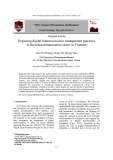
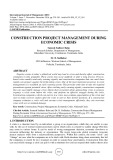
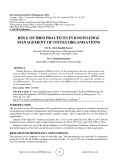
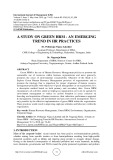
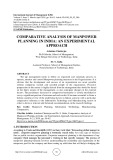
![Đề án quản lý và phát triển nhân sự tại đơn vị cấp phòng [Chuẩn SEO]](https://cdn.tailieu.vn/images/document/thumbnail/2017/20170419/msy1976/135x160/2751492583749.jpg)
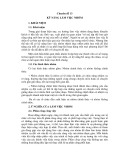

![Tài liệu đào tạo, bồi dưỡng lãnh đạo cấp phòng [Mới Nhất]](https://cdn.tailieu.vn/images/document/thumbnail/2017/20170210/nomoney3/135x160/2145657834.jpg)

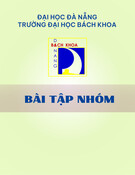
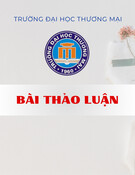






![20 câu hỏi Quản lý dự án phần mềm có đáp án [mới nhất]](https://cdn.tailieu.vn/images/document/thumbnail/2025/20251003/hieu2004haha@gmail.com/135x160/78791759734259.jpg)


![Tài liệu Quản lý dự án: Kiến thức nền tảng toàn diện [chuẩn SEO]](https://cdn.tailieu.vn/images/document/thumbnail/2025/20250910/kimphuong1001/135x160/92631757496585.jpg)



